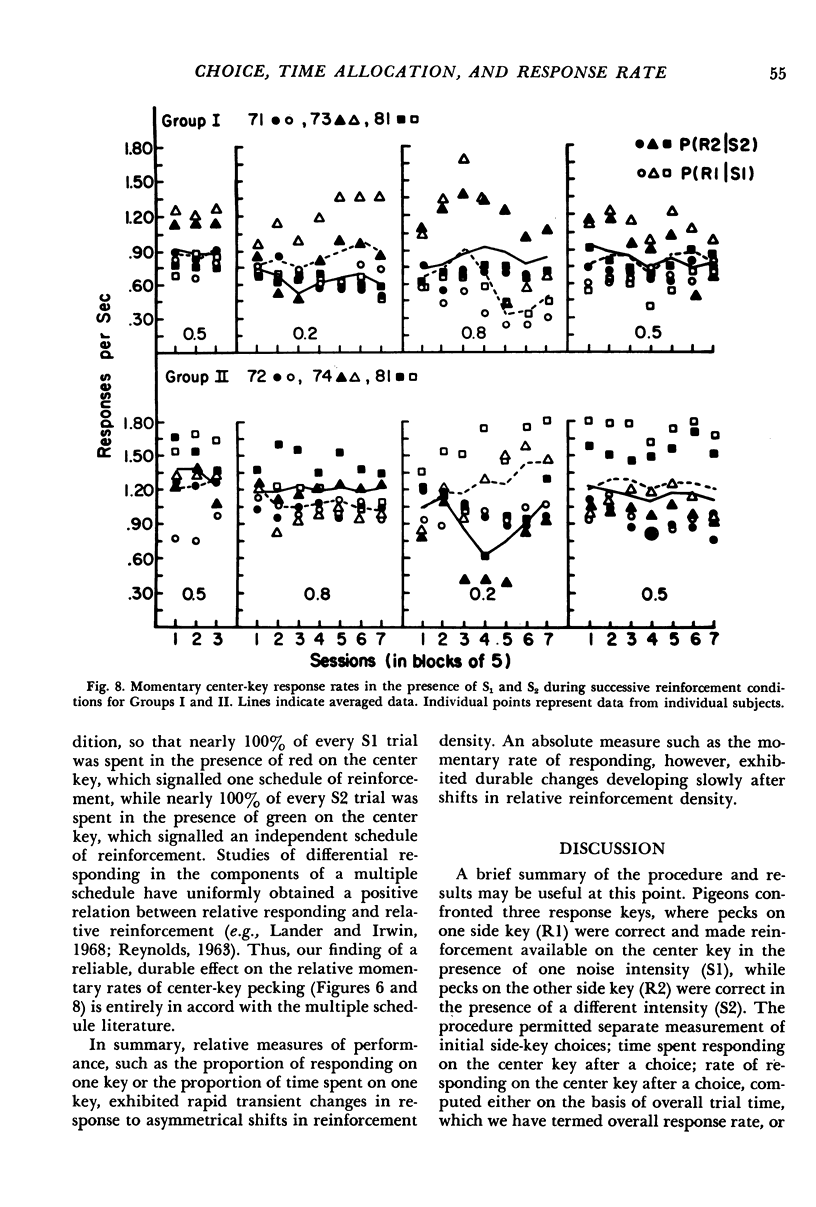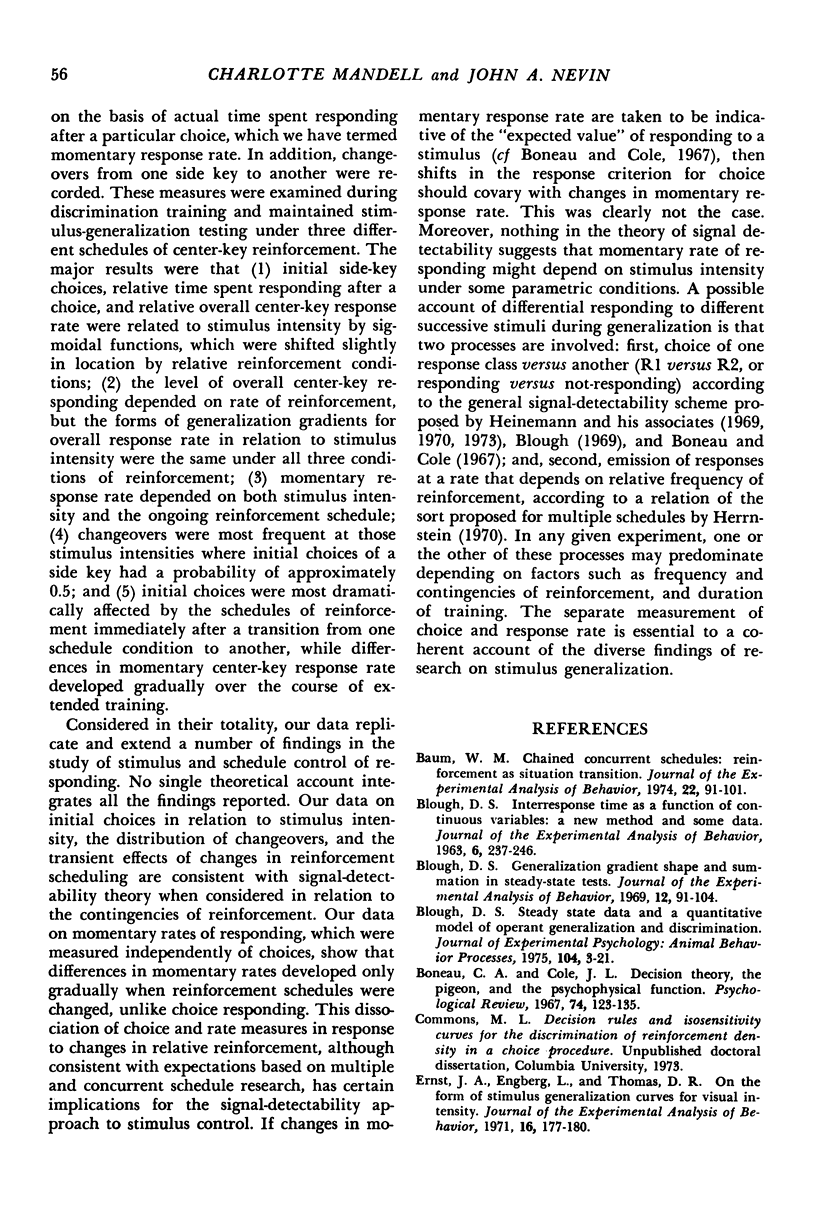Abstract
Six pigeons were trained to discriminate between two noise intensities using a procedure that assessed choice, time allocation, and response rate simultaneously and independently. Responses on the left or right key (R1 or R2) were respectively correct in the presence of two different intensities, S1 and S2. After a correct response, reinforcement became available for pecks on the center key. Reinforcement density for R1¦S1 relative to R2¦S2 was varied across experimental conditions. Generalization tests followed extensive training at each condition. As a function of stimulus intensity, proportions of initial choices of R2, of time spent in R2-initiated components, and of center-key responses emitted in R2-initiated components all yielded sigmoidal gradients of similar slope, which shifted slightly in location when relative reinforcement density changed. Changeovers were maximal where initial choice proportions approximated 0.5. Gradients relating the absolute number of center-key responses to stimulus intensity were also roughly sigmoidal, but were more sensitive to changes in reinforcement density. Gradients of momentary response rate also depended on reinforcement density. During training, large but transitory shifts in choice responding occurred when reinforcement density changed, while differences in momentary response rate developed slowly, suggesting separate control of choice and response rate by the contingencies of reinforcement.
Keywords: stimulus generalization, choice, time allocation, response rate, multiple schedules, concurrent schedules, auditory intensity, key peck, pigeons
Full text
PDF










Selected References
These references are in PubMed. This may not be the complete list of references from this article.
- Baum W. M. Chained concurrent schedules: reinforcement as situation transition. J Exp Anal Behav. 1974 Jul;22(1):91–101. doi: 10.1901/jeab.1974.22-91. [DOI] [PMC free article] [PubMed] [Google Scholar]
- Blough D. S. Generalization gradient shape and summation in steady-state tests. J Exp Anal Behav. 1969 Jan;12(1):91–104. doi: 10.1901/jeab.1969.12-91. [DOI] [PMC free article] [PubMed] [Google Scholar]
- Blough D. S. Interresponse time as a function of continuous variables: a new method and some data. J Exp Anal Behav. 1963 Apr;6(2):237–246. doi: 10.1901/jeab.1963.6-237. [DOI] [PMC free article] [PubMed] [Google Scholar]
- Boneau C. A., Cole J. L. Decision theory, the pigeon, and the psychophysical function. Psychol Rev. 1967 Mar;74(2):123–135. doi: 10.1037/h0024287. [DOI] [PubMed] [Google Scholar]
- Ernst A. J., Engberg L., Thomas D. R. On the form of stimulus generalization curves for visual intensity. J Exp Anal Behav. 1971 Sep;16(2):177–180. doi: 10.1901/jeab.1971.16-177. [DOI] [PMC free article] [PubMed] [Google Scholar]
- HABER A., KALISH H. I. PREDICTION OF DISCRIMINATION FROM GENERALIZATION AFTER VARIATIONS IN SCHEDULE OF REINFORCEMENT. Science. 1963 Oct 18;142(3590):412–413. doi: 10.1126/science.142.3590.412. [DOI] [PubMed] [Google Scholar]
- HANSON H. M. Effects of discrimination training on stimulus generalization. J Exp Psychol. 1959 Nov;58:321–334. doi: 10.1037/h0042606. [DOI] [PubMed] [Google Scholar]
- HEARST E., KORESKO M. B., POPPEN R. STIMULUS GENERALIZATION AND THE RESPONSE-REINFORCEMENT CONTINGENCY. J Exp Anal Behav. 1964 Sep;7:369–380. doi: 10.1901/jeab.1964.7-369. [DOI] [PMC free article] [PubMed] [Google Scholar]
- HERRNSTEIN R. J. Relative and absolute strength of response as a function of frequency of reinforcement. J Exp Anal Behav. 1961 Jul;4:267–272. doi: 10.1901/jeab.1961.4-267. [DOI] [PMC free article] [PubMed] [Google Scholar]
- Heinemann E. G., Avin E. On the development of stimulus control. J Exp Anal Behav. 1973 Sep;20(2):183–195. doi: 10.1901/jeab.1973.20-183. [DOI] [PMC free article] [PubMed] [Google Scholar]
- Herrnstein R. J. On the law of effect. J Exp Anal Behav. 1970 Mar;13(2):243–266. doi: 10.1901/jeab.1970.13-243. [DOI] [PMC free article] [PubMed] [Google Scholar]
- Honig W. K., Beale I. L. Stimulus duration as a measure of stimulus generalization. J Exp Anal Behav. 1976 Mar;25(2):209–217. doi: 10.1901/jeab.1976.25-209. [DOI] [PMC free article] [PubMed] [Google Scholar]
- Lander D. G., Irwin R. J. Multiple schedules: effects of the distribution of reinforcements between component on the distribution of responses between conponents. J Exp Anal Behav. 1968 Sep;11(5):517–524. doi: 10.1901/jeab.1968.11-517. [DOI] [PMC free article] [PubMed] [Google Scholar]
- MIGLER B. EFFECTS OF AVERAGING DATA DURING STIMULUS GENERALIZATION. J Exp Anal Behav. 1964 Jul;7:303–307. doi: 10.1901/jeab.1964.7-303. [DOI] [PMC free article] [PubMed] [Google Scholar]
- Migler B., Millenson J. R. Analysis of response rates during stimulus generalization. J Exp Anal Behav. 1969 Jan;12(1):81–87. doi: 10.1901/jeab.1969.12-81. [DOI] [PMC free article] [PubMed] [Google Scholar]
- Millenson J. R. Random interval schedules of reinforcement. J Exp Anal Behav. 1963 Jul;6(3):437–443. doi: 10.1901/jeab.1963.6-437. [DOI] [PMC free article] [PubMed] [Google Scholar]
- REYNOLDS G. S. Some limitations on behavioral contrast and induction during successive discrimination. J Exp Anal Behav. 1963 Jan;6:131–139. doi: 10.1901/jeab.1963.6-131. [DOI] [PMC free article] [PubMed] [Google Scholar]
- Stubbs A. The discrimination of stimulus duration by pigeons. J Exp Anal Behav. 1968 May;11(3):223–238. doi: 10.1901/jeab.1968.11-223. [DOI] [PMC free article] [PubMed] [Google Scholar]
- Stubbs D. A. Response bias and the discrimination of stimulus duration. J Exp Anal Behav. 1976 Mar;25(2):243–250. doi: 10.1901/jeab.1976.25-243. [DOI] [PMC free article] [PubMed] [Google Scholar]
- Wright A. A. Psychometric and psychophysical hue discrimination functions for the pigeon. Vision Res. 1972 Sep;12(9):1447–1464. doi: 10.1016/0042-6989(72)90171-x. [DOI] [PubMed] [Google Scholar]


